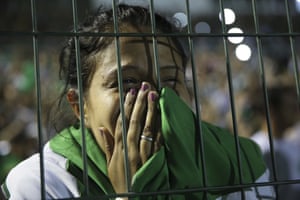Colombian media release audio of pilot telling air
traffic controllers that plane which
crashed killing 71 players, crew and journalists was ‘without fuel’. Leaked
audio shows pilot said he ran out of fuel.

Football, religion and grief dominated the emotional
requiem service in Southern Brazil on Wednesday night for the 71 players,
technical staff, sports journalists and crew killed when a plane chartered by
local team Chapecoense crashed on a Colombian mountainside on Wednesday night.
But there was anger too, at the reports circulating
that the plane had run out of fuel. On Wednesday night Brazil’s O Globo
newspaper said Colombian civil aviation authorities had confirmed there was no
fuel in the aircraft’s tank and have opened an investigation.
Delays getting from São Paulo to Bolivia, where the
team chartered the plane that crashed, meant a planned refuelling stop in
Cobija, Bolivia, was abandoned because the airport does not operate at night, O
Globo said.

It was a mistake, said Nataly Ferranti, 16, from the
team’s female youth team, that “ended lives, ended Chapecoense”. “I feel
indignation,” she said.
A leaked recording of the final minutes of the
doomed flight revealed a sometimes chaotic exchange with the air traffic tower,
with the pilot repeatedly requesting authorisation to land because of “fuel
problems”. A controller explained another plane had been diverted with
mechanical problems and had priority, instructing the pilot to wait seven
minutes.
As the plane circled in a holding pattern, the pilot
grew more desperate. “Complete electrical failure, without fuel,” he said in
the tense final moments before the plane set off on a four-minute death spiral
that ended with it slamming into a mountainside on Monday night. Just before
going silent the pilot made a final plea to land: “Vectors, señorita. Landing
vectors.”
On Wednesday night, at Chapecoense’s Condá Arena, a
Catholic priest and two evangelical preachers led prayers as fans wearing the
team’s green and white sang, cried and waved scarves and banners. “Switch on
your cellphones. Switch on the lights of your cellphones. It is the light of
God within us,” an announcer implored the crowd at one point. Applause greeted
the light show that followed. But the peak of an intensely emotional evening
came when the players and coaching staff who had not been on the flight, joined
by players from the youth teams, ran a lap of honour, some clutching each other
as tears poured down their faces and the roars of the crowd echoed around them.
“It helped a lot,” said João Lima, a youth team
player who ran in the lap of honour. “So many brothers lost in such a short
time. But we have to go forward and overcome.” Fans flooded into the Condá Arena long before
the service began. This modest little stadium is named after the club’s emblem,
an indigenous warrior of the same name. A statue on a nearby roundabout shows
him pulling back his bow and arrow, with neat white and green brushstrokes of
colour on his cheeks.
The word “warrior” was used in the service to
describe the 19 players who died on their way to their first-ever international
final, the first leg of the South American Cup, against Medellín’s Atlético
Nacional. The Colombian team also held a service on Wednesday for a huge crowd.
“I don’t have words to describe the scale of what the Colombian people did
today,” tweeted Brazilian journalist and blogger Raphael Tsavvko. “Warrior” is
widely used in Brazil to describe those who struggle against the odds just like
this team of non-league underdogs who entered Brazil’s fourth division only in
2009, and yet by 2014 were playing in its premier league.
There was long, intense applause when the players’
photographs, and those of the technical staff who died, appeared on big
screens. Six survivors including three
Chapecoense players are recovering in
hospitals, with three of them in a critical but stable condition.
The club’s mascot, Cleiton Majolo, a driver’s
assistant, wears a costume based on the indigenous warrior Condá. “It is a
nightmare for us that we will not see our friends. It seems like we will never
wake up,” Majolo said before the service, having removed his plastic mask. He
would have gone on the trip to Colombia, he said, if he had only had a
passport. “And I wouldn’t be here,” he said. Local psychologists have been
volunteering to help the club’s survivors deal with the trauma. But recovery
will be a slow process, André Pedrosa, one of those offering their work for free,
said earlier on Wednesday. “It is a wound that has been opened and people will
have to learn to live with it,” he said. “Pain, and a lot of suffering.”
After the ceremony, as supporters still sang team
songs, many loitered on the pitch. Caroline Machado and her friend Samira Reis
hugged each other and cried. Machado grew up around the club. Her uncle Eduardo
Preuss, known as Cadu Gaúcho, was a key member of the coaching staff that had
put together a team of underdogs good enough to reach the final of the second
most important trophy in South America. He died in the crash. But the team will
play on, she vowed. “We will not let this story die,” she said. “They would not
have wanted us to.”
No comments:
Post a Comment
Leave Comment Here